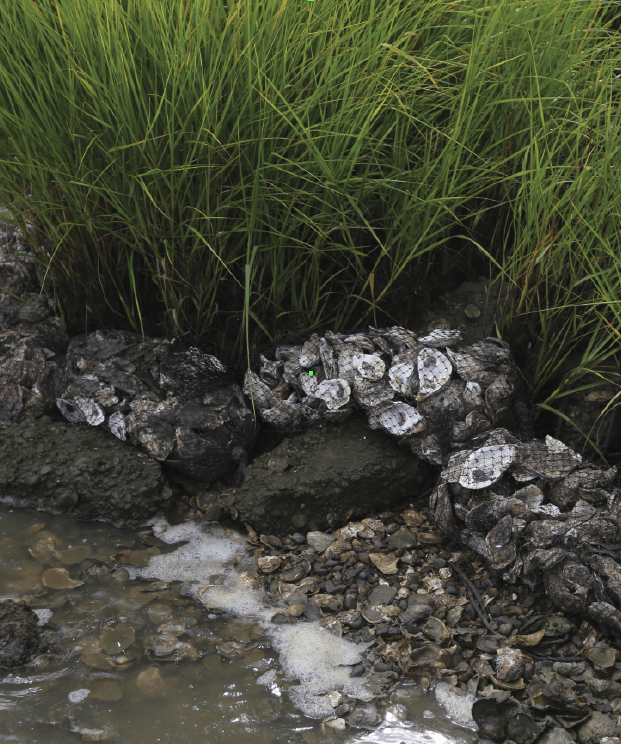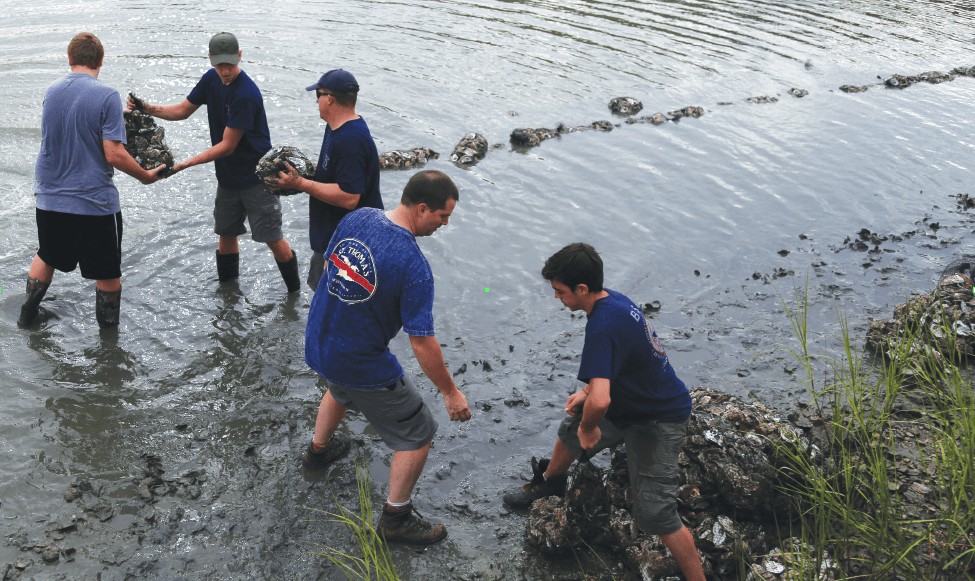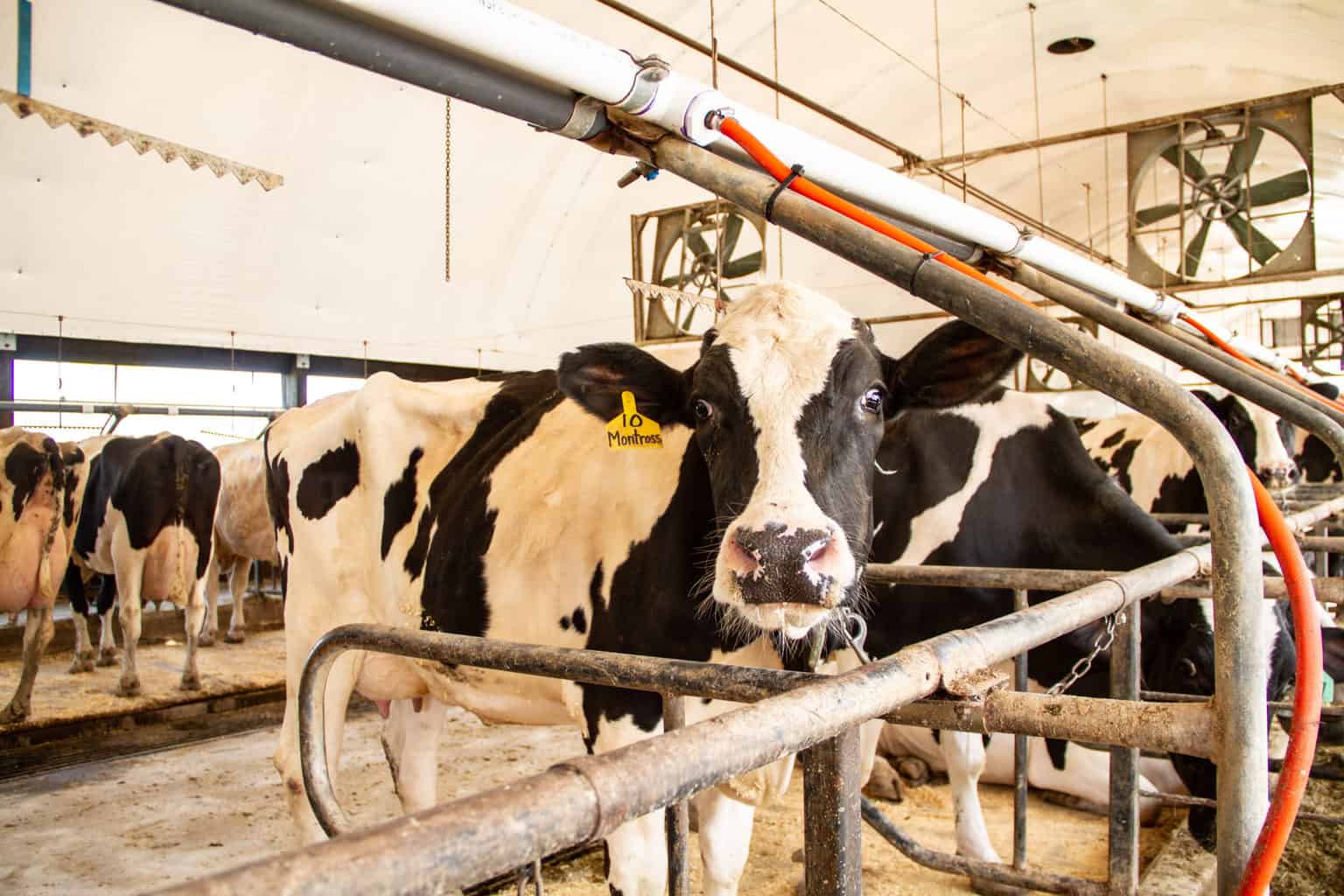Local Eagle scout teams up with Volvo Penta and local conservation alliance to revive Chuckatuck Creek.
by Tyler Beckett
Boy Scout volunteers build a Chuckatuck barrier with bags of oyster shells. by Volvo Penta PhotosIt takes work to maintain local waterways, especially when that water helps sustain your town. Suffolk gets to see the preservation efforts for the Nansemond and James Rivers up close, so when there’s major erosion or when oysters die off in huge numbers, the residents know it. They see the EPA spend hundreds of millions a year on managing run-off and cleaning the waterways, and locals are likely grateful for the improvements—but that doesn’t mean they aren’t part of the solution. Far from it.
This July, 15 year-old Boy Scout Colton Brown led a local project to build an oyster reef off Chuckatuck Creek in Suffolk, which flows into the Nansemond and James Rivers. Brown worked at the Volvo Penta Test Center to create a protective barrier using seven hundred pounds of oyster shells, which will slow erosion and provide ideal habitat for new oysters. But the oysters aren’t there for harvesting— they’re there to clean up the water.
“The water’s pretty filthy now and it’s getting worse,” Brown explains. “When I was in the seventh grade, we had this lady come in and she talked about how oysters clean water. [I realized] I could make a whole oyster reef and I could filter a bunch of water if I get live oysters.”
Oysters are efficient natural water filters of algae and sediment. A single adult oyster can filter as much as two gallons of water an hour. Scientists have theorized that prior to 1870, the Chesapeake Bay ‘s oyster populations filtered an amount equal to the entire Bay—18 trillion gallons—in a week. As of 2008, their population was low enough that it would take a year to accomplish the same feat. That’s part of why Brown’s project is an important step in the right direction.

The members of Boy Scout Troop 73 joined Brown at the Volvo Testing Center early one Saturday morning and waded into the water to shovel out the oyster shells and plant grass along the edge. Brown managed the project and directed the activity—an important part of his Eagle Project. The project is the culmination of a scout’s experience before attaining the highest rank, and as such, the scout must do the bulk of the planning, funding, and execution. For Brown, it’s a high point in the near-decade he’s spent scouting.
It was also the culmination of recent months of work. Just a few weeks before the project, a dump truck delivered the seven hundred pounds of oyster shells to the Brown’s driveway, courtesy of the Chuckatuck Ruritan Club’s 2017 Oyster Roast. Brown had decided to clean them all himself. “You spray them off with a hose. You throw them all out in the grass then spray them, then you take the clean ones and put them in a clean pile and keep doing that,” Brown explained, laughing at the memory of the repetitive hours of labor. “I spent days out there.”
The Boy Scouts and Brown’s family provided a great deal of support for the project, but none of it would have been possible without the Nansemond River Preservation Alliance (NRPA) and the Volvo Penta Test Center staff. Their expertise and experience with the river helped ensure the project would do the most good possible.
Bob Crocker, Manager of Product Testing at Volvo Penta, is particularly eager to talk about the work they’ve done with Brown and past Boy Scouts. “[Our first project] was two years ago with a scout. He planted the grass and did the same thing, planted the oysters as well,” Crocker said. “We had environmentalists saying, ‘Oh it wouldn’t grow along here,’ and it’s done just phenomenal. Long term, the more grass you get, it acts as a great filter. It gives the smaller marine creatures a place to hide and nourish and grow. As far as the ecological system, it’s fantastic.”
The expanding grass beds, the resurgent oysters, and all the other marine life that has made its way back to the Chuckatuck is a good sign for
the area. The NRPA advocates for environmental friendliness and teaches conservation to middle school students.
“A lot of them will stay here, and a lot of them are growing up here. It’s about how people take ownership in the river,” NRPA Education Program Co-Director John Wass said. “If they take ownership in the river then it’s like, ‘Oh don’t mess with it,’ right? And they want to protect it.”
If Colton Brown and the other Scouts are any indication, the next generation of leaders and environmental protectors is already here.
Tyler Beckett is a recent Old Dominion graduate with an MFA in creative writing.




